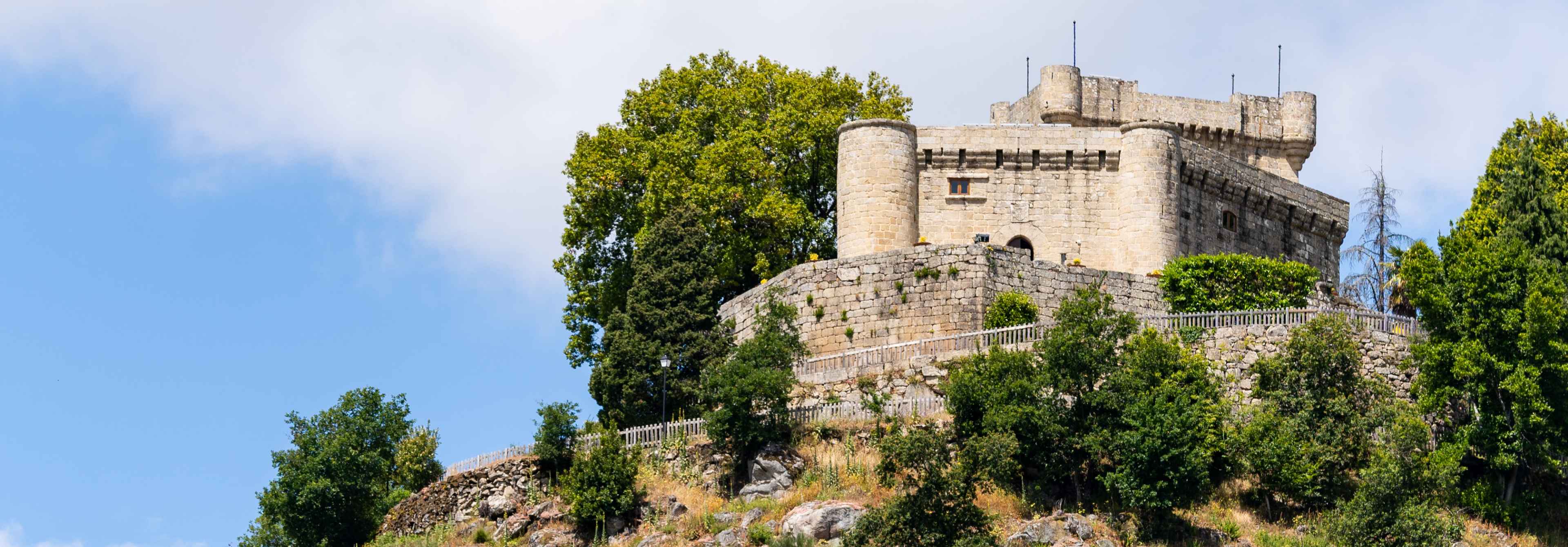History
Sobroso Castle was built in order to control an essential crossroad between the southern Galicia inlands, the sea and Tui city in the south. It is located in mount Landín: a place with great visual control and of difficult access. It was part of a defensive system which, together with other fortresses like Soutomaior, Tebra or Torre de Fornelos, protected the “tierra de Toroño” or Turonium lands. Turonium was made up of the king lands inside Tui bishopric jurisdiction.
It is located in the Vilasobroso parish term (a traditional Galician division), known before as San Martiño de Portela, and belongs to the municipality of Mondariz. Its name evokes the cork trees (sobreiras in Galician) that used to be atop the hill, surrounding the castle in mystery, and nurturing the numerous legends in which it acts both as stage and protagonist.
Just as it happens with a good number of medieval structures in Galicia, we are not sure about the origins of Sobroso Castle. There is a document from 1095 referring to Lady Urraca and Lord Raymond of Burgundy, Counts of Galicia, and suggesting they might have given lordship over the castle to the city of Tui, but such interpretation is still under dispute.
There are more solid news on its existence in the 12th century.
The “Historia Compostelana”, narrating the events that happened to Diego Gelmírez —first Bishop of Santiago de Compostela— tells us how Queen Urraca was besieged inside the castle in 1117. Her own sister, Lady Theresa of Portugal, together with Lord Pedro Froilaz, Count of Traba, encircled the castle and forced the queen to run away to León. Legend says that she could escape thanks to an underground tunnel leading to the nearby Tea River. This episode in the struggle for power between Urraca and her heir Alfonso —future King Alfonso VII the Emperor— is a crucial moment in the history of the castle. But it would not be the only one.
The House of Traba, lineage of Lord Pedro Froilaz, was a Galician high-ranking noble family during the 12th and 13th centuries. They represented Galicia, as they held the title of counts of the realm. As such, they owned numerous strongholds in the region, including Sobroso.
The Castro substituted them in the early 14th century.
Nevertheless, after the battle of Puerto de Bueyes, near Baiona, in 1371, Pedro Ruiz Sarmiento together with Pedro Manrique defeated Fernando de Castro —supporter of Pedro I against Henry II of Trastámara, who was backed by the Sarmientos. Consequently, the House of Sarmiento finally settled in Galicia. Thus, the rise to power of a dynasty that gained lordship over Ribadavia and reached control over the region now named Salvaterra after them started. Since 1379, they ruled over Sobroso too, leaving their mark as no other family in the fortress, which had become head of an ample territory.
This was the beginning of a series of conflicts between the Sarmiento and the Sotomayor —two of the main houses disputing for power in southern Galicia. Weddings, litigations, duels and deaths in a dynastic fight that gave us some amazing stories. One such story tells how Pedro Álvarez de Sotomayor (known as Pedro Madruga, as he was an “early riser”) captured García Sarmiento —Lord of Sobroso— in a raid and, holding his sword against the prisoner's throat, demanded the surrender of the castle. The defenders refused, and despite Madruga's repeated attempts, he could not capture the bastion.
The castle ended up passing from hand to hand repeatedly in an era marked by war and bloody struggle for power between nobles until the pacification of Galicia undertook by the Catholic Monarchs, Isabella and Ferdinand.
The fortress was destroyed and rebuilt after the Great Irmandiña War and lost its defensive relevance over time. It became the main residence of the Sarmientos —who obtained the title of Marquises of Sobroso in 1625— until the 17th century. It was then when it became a ruin, little by little, due to its abandonment. In fact, the castle was in that state when the Countess of Pardo Bazán came across its ruins.
The abandonment of the castle in the 17th century, took place as a result of the departure of the main representatives of Galician nobility, who started to leave their castles to go live at court, where it was easier to gain influence over politics and the king. At that moment, the castle was controlled by merinos, who slowly saw the decline and fragmentation of their control over territory, parallel to the decay of the fortress until it fell into ruins in the 19th century.
This situation goes on until its last owner, Alejo Carrera, born and raised in Vilasobroso, bought it from the Count of Torrecedeira in 1923. Its reconstruction became his life’s mission. This prominent journalist, politician and philanthropist was the last lord of the castle. However, the history of this amazing monument is not only the one of its most distinguished occupants. Masons, cooks, servants, soldiers, troubadours… and maybe even fabled mouras and trasnos: all their lives intertwined with the castle and moulded its history.





